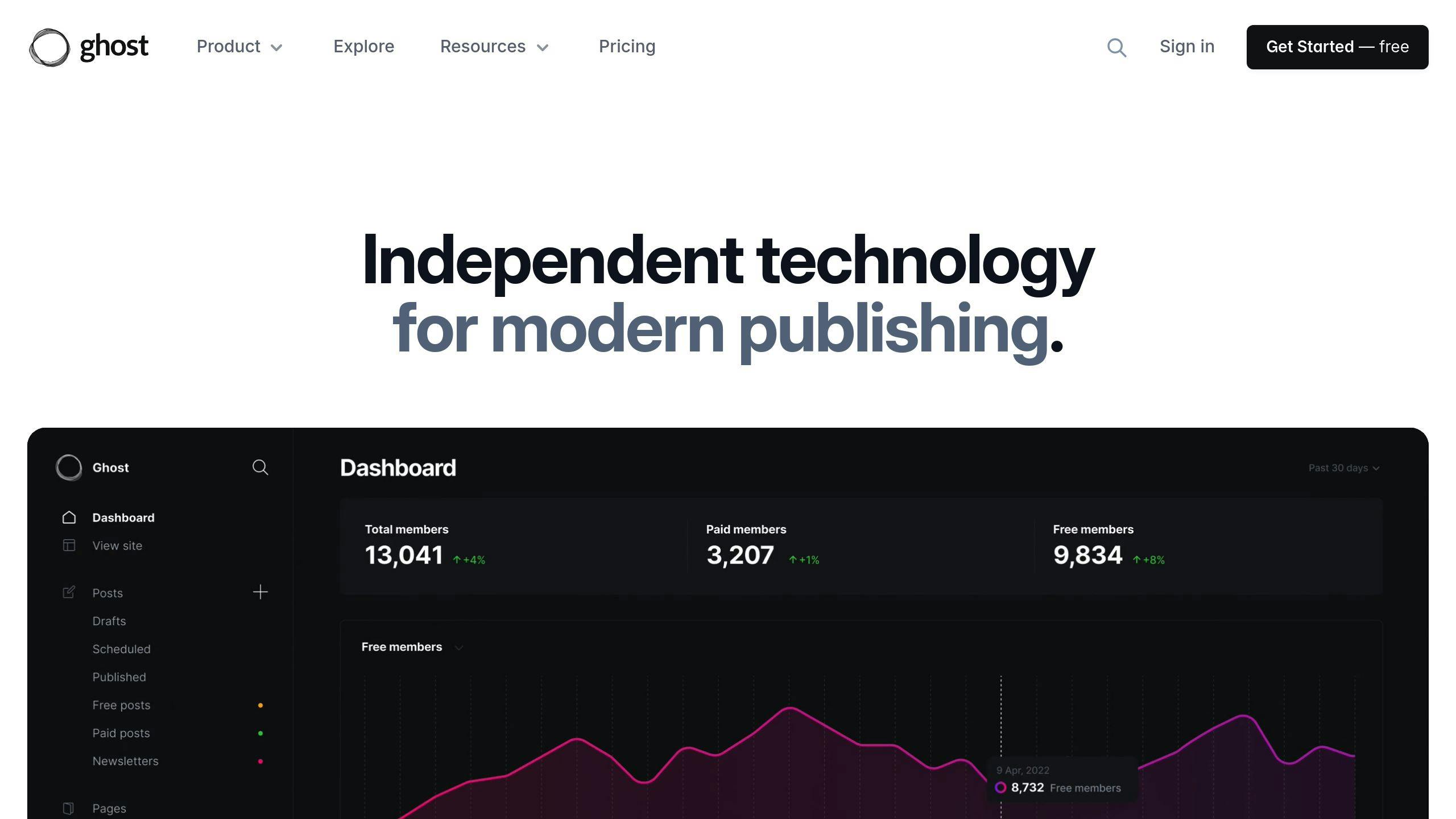- Substack: Keeps it simple with subscription-based income. Creators keep 85% of revenue but pay a 10% platform fee. Great for independent writers.
- Ghost: Offers full control with no revenue sharing. Ideal for creators who want customization and own their content but requires technical setup.
- Patreon: Focuses on community with tiered memberships and perks. Creators keep 92% of earnings but have limited email tools.
- Beehiiv: Excels in analytics and ad monetization. Flexible pricing plans make it perfect for data-driven creators.
Quick Comparison
| Platform | Revenue Model | Fees | Best For |
|---|---|---|---|
| Substack | Subscriptions (10% fee) | 10% + processing | Independent writers |
| Ghost | Direct payments (no platform fee) | Hosting costs | Publishers with tech skills |
| Patreon | Membership tiers (5% fee) | 5% + processing | Community-focused creators |
| Beehiiv | Subscriptions + ads | Starts at $0/month | Data-driven publishers |
Each platform has unique strengths. Substack is user-friendly, Ghost is customizable, Patreon builds community, and Beehiiv focuses on analytics. Choose based on your goals and technical expertise.
Beehiiv vs Substack: Making Money with Newsletters
1. Substack Overview
Substack has become a popular choice for newsletter creators, thanks to its easy-to-use monetization system and tools for building engaged communities. Here's a closer look at what makes it effective for generating revenue.
Monetization Structure
Substack operates on a clear revenue-sharing model: creators keep 85% of their subscription earnings, while the platform takes a 10% cut, along with standard payment processing fees (2.9% + 30¢ per transaction). There are two main ways to earn on Substack:
- Paid subscriptions: Charge readers a recurring fee for exclusive content.
- Voluntary contributions: Let supporters contribute without requiring a subscription.
Community Features
Substack includes tools designed to boost engagement, which can directly impact earnings. These features include:
| Feature | How It Helps Revenue |
|---|---|
| Discussion threads | Keeps subscribers engaged, encouraging renewals. |
| Comment sections | Builds loyalty through direct interaction. |
| Simple publishing tools | Makes it easy to post regularly and keep readers engaged. |
Platform Success
As of 2023, Substack has attracted over 2 million paid subscribers across its platform. Its success lies in its focus on simplicity, allowing creators to prioritize producing great content without getting bogged down by technical challenges.
Pricing Strategy
Substack creators can tailor their pricing based on their goals and market positioning. Options include cost-based pricing (covering expenses), value-based pricing (reflecting content quality), or market-based pricing (matching competitors). The key to success lies in delivering consistent, high-quality content that justifies the price and keeps subscribers engaged.
Substack makes it easy for creators to focus on content and community, but other platforms, like Ghost, offer additional flexibility. Let’s dive into Ghost’s features next.
2. Ghost Features

Ghost is a platform designed to help creators monetize newsletters while maintaining full control over their revenue. It focuses on content-first publishing and offers advanced tools to manage paid subscriptions with ease.
Monetization Structure
Ghost uses Stripe for secure payment processing and provides built-in tools to handle both free and paid subscribers. Creators can set custom pricing tiers and segment their audience effectively. Plans start at $9/month for up to 1,000 subscribers, with costs increasing as your audience grows.
Platform Capabilities
Ghost allows creators to customize their newsletters extensively, from templates to advanced design options. It also supports managing members-only content, audience segmentation, and personalized communication. These tools help creators establish a strong and professional brand identity while keeping their audience engaged.
Key features include:
- Members-only content
- Audience segmentation
- Personalized newsletters
- Custom domain setup
- Professional comment management
Success and Integration
Notable newsletters like The Browser and Tangle have successfully used Ghost's subscription tools to generate revenue and build loyal communities. The platform integrates smoothly with tools like email marketing services, analytics, and CRM systems, offering a complete publishing solution to maximize revenue.
Ghost’s tools are perfect for creators who want full control over their monetization and branding. While Ghost focuses on ownership and customization, Patreon takes a more community-focused approach. Let’s dive into how Patreon operates.
sbb-itb-2653e19
3. Patreon Details
How Monetization Works
Patreon uses a tiered membership system for monetizing newsletters. Creators keep 92% of their earnings, with Patreon taking a 5% commission and the rest going to standard payment processing fees.
Membership Tiers and Subscriber Perks
Creators can attract subscribers by offering perks like exclusive content, early access, behind-the-scenes updates, and direct communication. These tiers help creators cater to different audience segments, giving each group something tailored to their interests.
Tools for Community Engagement
Patreon offers several features to help creators connect with their audience and boost newsletter monetization:
| Feature | Purpose |
|---|---|
| Community Posts | Keeps subscribers engaged with regular updates |
| Polling Tools | Gathers feedback to refine content |
| Live Streaming | Enables real-time interaction with the audience |
| Direct Messaging | Allows personal communication with subscribers |
Platform Impact
Since its launch, Patreon has generated over $1 billion in earnings for creators. Notably, 75% of creators on the platform report increased earnings, underscoring its value as a monetization tool.
Integration Options
Patreon works seamlessly with platforms like WordPress, Discord, social media, and various analytics tools, making it easier for creators to manage their content and connect with their audience.
Keys to Success
To thrive on Patreon, creators need to stick to regular content schedules and actively engage with their communities. This consistent interaction helps build loyalty and drives both retention and growth.
While Patreon shines in community engagement and tiered rewards, Beehiiv differentiates itself with advanced analytics and tools focused on audience growth.
4. Beehiiv Insights
Monetization Features
Beehiiv offers tools designed to help creators earn through paid subscriptions and ad placements. Its analytics dashboard provides detailed insights into subscriber engagement and revenue, giving creators the information they need to fine-tune strategies and boost earnings.
Pricing Structure
Beehiiv has a flexible pricing model with several tiers to suit different needs:
| Plan | Price | Features |
|---|---|---|
| Free | $0/month | Up to 2,500 subscribers, unlimited sends |
| Launch | $29/month | Custom domains, basic analytics |
| Scale | $39/month | Ad networks, premium subscriptions |
| Max | Custom | Enterprise features, priority support |
Analytics and Growth Tools
Beehiiv excels in analytics, offering a range of tools to track and understand performance. Key metrics include:
- Subscriber growth patterns
- Email engagement statistics
- Revenue monitoring
- Audience segmentation insights
Customization and Design
Beehiiv emphasizes clean, professional designs that enhance readability and user engagement. However, its template options are more limited compared to some competitors.
Audience Management
The platform's segmentation tools allow creators to target specific audience groups, tailor content delivery, and improve both engagement and revenue strategies.
Integration Capabilities
Beehiiv supports integration options essential for newsletter monetization. However, its focus remains on core publishing and analytics features rather than a wide range of third-party tools.
Platform Advantages
For creators focused on monetization, Beehiiv offers several standout features:
- Advanced analytics dashboard
- Built-in ad network functionality
- Flexible subscription options
- Automated revenue tracking
- Tools for audience growth
This combination of features makes Beehiiv a strong choice for creators who rely on data to drive their decisions.
While Beehiiv shines in monetization and analytics, how does it stack up against other platforms in terms of overall performance and additional features?
Strengths and Weaknesses of Each Platform
Every newsletter platform comes with its own set of pros and cons when it comes to monetization. Here's a side-by-side comparison to help you decide which one suits your goals.
| Platform | Key Strengths | Limitations | Best For |
|---|---|---|---|
| Substack | • Easy-to-use interface • Built-in audience • Strong brand presence |
• 10% platform fee • Limited customization options • Basic analytics tools |
Independent writers |
| Ghost | • No platform fees • Highly customizable • Complete ownership of content |
• Requires technical setup • More complex to use • Hosting must be managed separately |
Publishers with technical expertise |
| Patreon | • Flexible membership tiers • Strong community features • Large userbase |
• 5% platform fee • Indirect newsletter tools • Limited email capabilities |
Creators offering diverse content formats |
| Beehiiv | • Detailed analytics • Built-in ad network • Flexible pricing options |
• Limited design templates • Relatively new platform • Fewer integrations |
Publishers focused on data and analytics |
Monetization and Engagement Comparison
The way each platform handles monetization and community engagement can greatly affect your revenue potential. Here's a quick breakdown:
| Feature | Revenue Options | Engagement Tools |
|---|---|---|
| Substack | Subscriptions with 10% platform fee | Comments, discussion threads |
| Ghost | Direct Stripe payments, no fees | Segmentation, members-only content |
| Patreon | Membership tiers with 5% fee | Rewards, direct messaging |
| Beehiiv | Ad revenue + subscriptions | Advanced targeting, analytics tools |
Platform Highlights
Substack is perfect for writers who want simplicity and access to a ready-made audience. Ghost, on the other hand, is ideal for those who prioritize full control and customization. Patreon stands out for creators who offer multiple types of content and benefit from its tiered membership model. Beehiiv is a great choice for data-focused publishers looking to maximize revenue through analytics and ad opportunities.
How Community Features Affect Revenue
The community engagement tools offered by these platforms can directly impact how well you monetize your content:
- Substack: Tools like discussion threads help retain subscribers.
- Ghost: Personalized content keeps premium members engaged.
- Patreon: A rewards system builds strong loyalty among patrons.
- Beehiiv: Audience segmentation improves conversion rates.
This comparison highlights the key features and limitations of each platform, helping you identify the best fit for your newsletter strategy.
Final Thoughts
Different platforms cater to different types of creators. Substack is a great option for independent writers who want an easy-to-use system with built-in subscription tools and an existing audience. However, keep in mind that its 10% revenue share could affect your earnings over time.
Ghost is a strong choice for publishers who want full control over their monetization. With no revenue sharing and direct Stripe integration, it allows creators to offer flexible payment options, including monthly and yearly subscriptions, which can help with financial planning.
Beehiiv shines when it comes to analytics and offers multiple ways to earn, such as subscriptions and ads. This makes it a great fit for creators who rely on data to guide their strategies. On the other hand, Patreon focuses on building a sense of community. Its tiered membership model and tools for audience engagement make it a versatile platform for creators offering a mix of content.
When considering costs, think about how the platform's setup process and long-term earning potential match your goals. Choosing the right platform depends on your technical skills, content plans, and how you want to connect with your audience.


